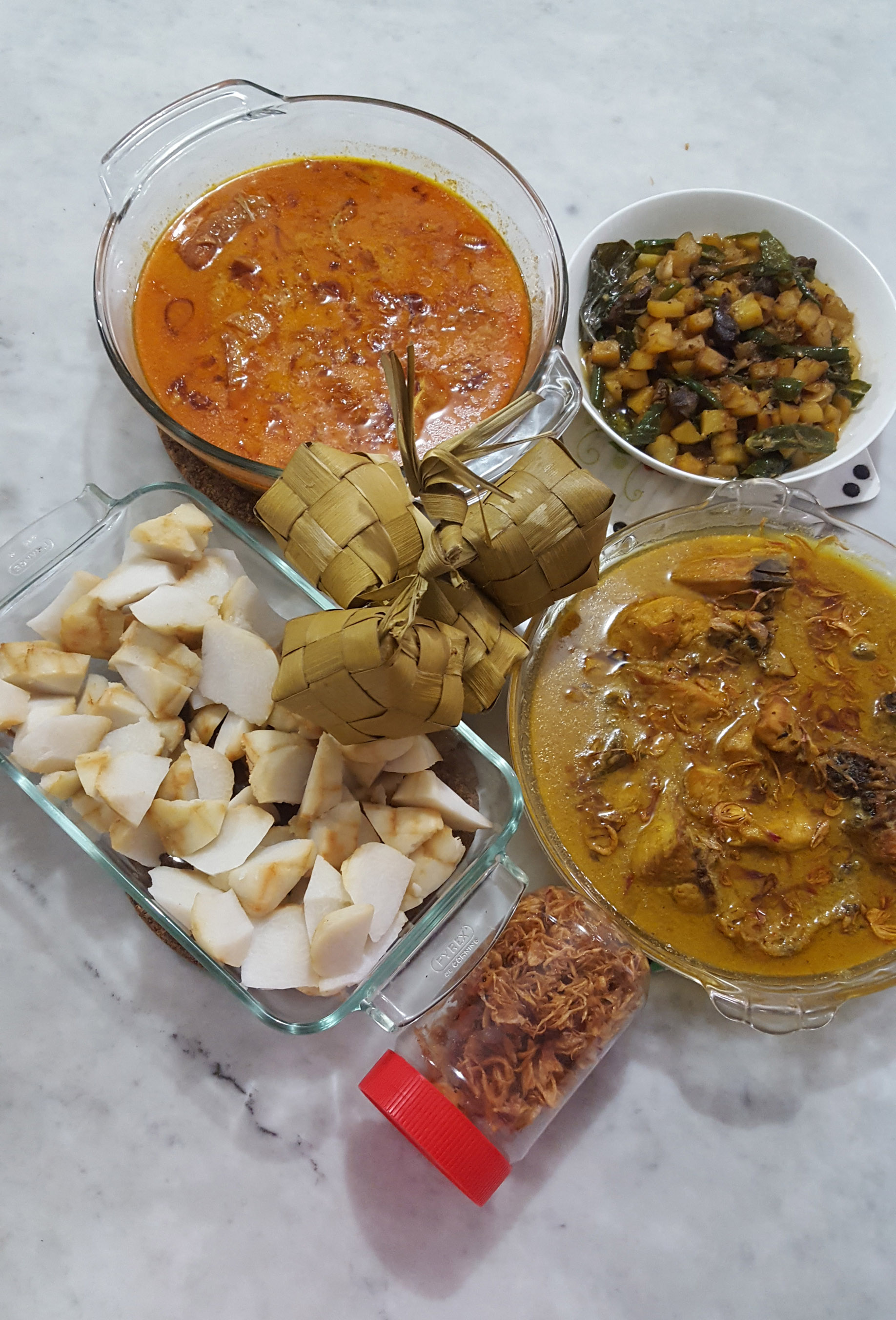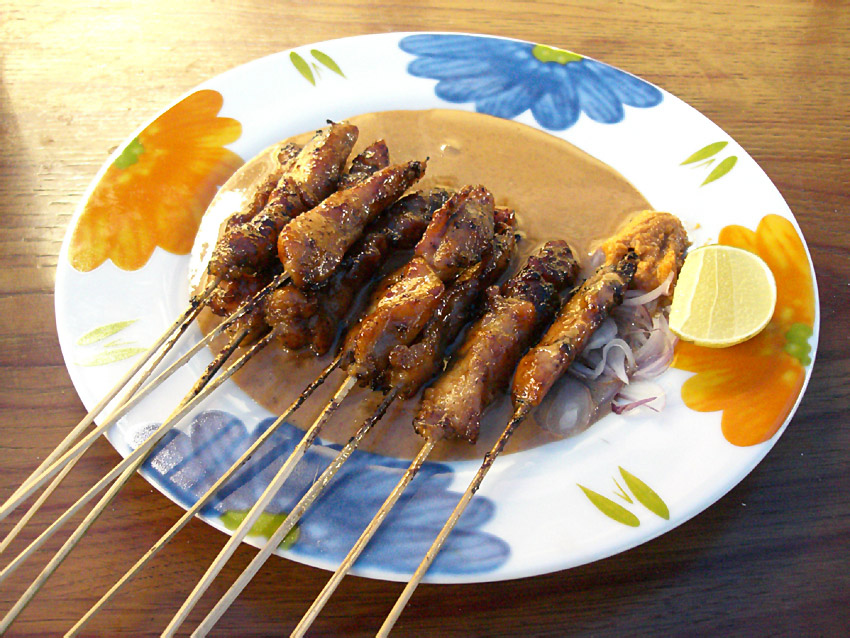|
Siomay
Siomay (also Somai), is an Indonesian steamed fish dumpling with vegetables served in peanut sauce. It is derived from the Chinese Shumai. It is considered a light meal, similar to the Chinese Dim Sum. It is traditionally made from pork but is frequently substituted with ''tenggiri'' (spanish mackerel), as many Indonesians observe the ''halal'' dietary law. Sometimes other types of seafood such as tuna, mackerel, and prawn also can be used to make siomay. Other complements to siomay include steamed cabbage, potatoes, bitter gourd, boiled egg, and tofu. Siomay is often cut into bite size pieces and topped with peanut sauce, sweet soy sauce, chili sauce and a dash of lime juice. Origin and varieties Siomay is ubiquitous in Indonesian cities, it is one of the most popular snack or light meal in Indonesia. It can be found in street-side food stalls, travelling carts, bicycle vendors, and restaurants, and is considered a popular school meal for Indonesian students. Just like ''bakso, ... [...More Info...] [...Related Items...] OR: [Wikipedia] [Google] [Baidu] |
Shumai
''Shumai'' () is a type of traditional Chinese dumpling. In Cantonese cuisine, it is usually served as a dim sum snack.Hsiung, Deh-Ta. Simonds, Nina. Lowe, Jason. 005(2005). The food of China: a journey for food lovers. Bay Books. . p 38. In addition to accompanying the Chinese diaspora, a variation of shumai also appears in Japan as (, ''shūmai'') and various southeast Asian countries. Popular Chinese varieties Hohhot ''shaomai'' Hohhot shaomai is a regional variety in Hohhot, Inner Mongolia. The wrapping is a very thin, round sheet of unleavened dough, with a pleat border. There is only one kind of filling, which mainly consists of chopped or minced mutton, scallion and ginger. Hohhot shaomai features this extensive use of scallion and ginger, creating a dense combined scent, and a slightly spicy taste. The filling is put in the center of the wrapping and the border of the wrapping is loosely gathered above, forming a "neck" and a flower shaped top. It is then cooked b ... [...More Info...] [...Related Items...] OR: [Wikipedia] [Google] [Baidu] |
Shumai
''Shumai'' () is a type of traditional Chinese dumpling. In Cantonese cuisine, it is usually served as a dim sum snack.Hsiung, Deh-Ta. Simonds, Nina. Lowe, Jason. 005(2005). The food of China: a journey for food lovers. Bay Books. . p 38. In addition to accompanying the Chinese diaspora, a variation of shumai also appears in Japan as (, ''shūmai'') and various southeast Asian countries. Popular Chinese varieties Hohhot ''shaomai'' Hohhot shaomai is a regional variety in Hohhot, Inner Mongolia. The wrapping is a very thin, round sheet of unleavened dough, with a pleat border. There is only one kind of filling, which mainly consists of chopped or minced mutton, scallion and ginger. Hohhot shaomai features this extensive use of scallion and ginger, creating a dense combined scent, and a slightly spicy taste. The filling is put in the center of the wrapping and the border of the wrapping is loosely gathered above, forming a "neck" and a flower shaped top. It is then cooked b ... [...More Info...] [...Related Items...] OR: [Wikipedia] [Google] [Baidu] |
Batagor
Batagor (abbreviated from ''Bakso Tahu Goreng'', Sundanese and Indonesian: "fried bakso ndtofu") is a Sundanese dish from Indonesia, and popular in Southeast Asia, consisting of fried fish dumplings, usually served with peanut sauce. It is traditionally made from minced ''tenggiri'' (Spanish mackerel), although other types of seafood such as tuna, mackerel, and prawn may also be used. The fish paste is subsequently stuffed into wonton skins or filled into tofu, and then deep fried in palm oil. Street-side batagor fried dumplings are usually served with fried tofu and finger-shaped fried ''otak-otak'' fish cakes. These batagor components are cut into bite-size pieces and topped with peanut sauce, ''Kecap manis'' (sweet soy sauce), ''sambal'' (chili paste), and lime juice. As a fried food, batagor generally have a crispy and crunchy texture; since its serving method is identical, batagor and siomay are often sold by the same vendor, with batagor being offered as a crispy variation ... [...More Info...] [...Related Items...] OR: [Wikipedia] [Google] [Baidu] |
List Of Steamed Foods
This is a list of steamed foods and dishes that are typically or commonly prepared by the cooking method of steaming. Steamed foods * Ada – a food item from Kerala, usually made of rice flour with sweet filling inside. * Bánh – in Hanoi Vietnamese, translates loosely as "cake" or "bread", referring to a wide variety of prepared foods. Some varieties are cooked by steaming. ** Bánh bò – a steamed sponge cake ** Bánh bột lọc ** Bánh chuối hấp – literally "steamed banana cake" ** Bánh cuốn ** Bánh da lợn – a steamed layer cake ** Bánh khoai mì hấp ** Bánh tẻ * Chinese steamed eggs – eggs are beaten to a consistency similar to that used for an omelette and then steamed * Corunda * Couscous * Dhokla * Jjim – a Korean cuisine term referring to dishes made by steaming or boiling meat, chicken, fish, or shellfish which have been marinated in a sauce or soup ** Agujjim ** Andong jjimdak ** Galbijjim – a variety of ''jjim'' or Korean stea ... [...More Info...] [...Related Items...] OR: [Wikipedia] [Google] [Baidu] |
Chinese Indonesian Cuisine
Chinese Indonesian cuisine ( id, Masakan Tionghoa-Indonesia, ) is characterized by the mixture of Chinese with local Indonesian style. Chinese Indonesians, mostly descendant of Han ethnic Hokkien and Hakka speakers, brought their legacy of Chinese cuisine, and modified some of the dishes with the addition of Indonesian ingredients, such as ''kecap manis'' (sweet soy sauce), palm sugar, peanut sauce, chili, ''santan'' ( coconut milk) and local spices to form a hybrid Chinese-Indonesian cuisine. Some of the dishes and cakes share the same style as in Malaysia and Singapore, known as Nonya cuisine by the Peranakan. Chinese cuisine legacy Chinese influences are evident in Indonesian food. Popular Chinese Indonesian foods include ''bakmi'', ''mie ayam'', ''pangsit'', ''bakso'', ''lumpia'', ''kwetiau goreng'' and '' mie goreng''. Chinese culinary culture is particularly evident in Indonesian cuisine through the Hokkien, Hakka, and Cantonese loanwords used for various dishes. ... [...More Info...] [...Related Items...] OR: [Wikipedia] [Google] [Baidu] |
Indonesian Chinese Cuisine
Chinese Indonesian cuisine ( id, Masakan Tionghoa-Indonesia, ) is characterized by the mixture of Chinese with local Indonesian style. Chinese Indonesians, mostly descendant of Han ethnic Hokkien and Hakka speakers, brought their legacy of Chinese cuisine, and modified some of the dishes with the addition of Indonesian ingredients, such as ''kecap manis'' (sweet soy sauce), palm sugar, peanut sauce, chili, ''santan'' (coconut milk) and local spices to form a hybrid Chinese-Indonesian cuisine. Some of the dishes and cakes share the same style as in Malaysia and Singapore, known as Nonya cuisine by the Peranakan. Chinese cuisine legacy Chinese influences are evident in Indonesian food. Popular Chinese Indonesian foods include ''bakmi'', ''mie ayam'', ''pangsit'', ''bakso'', ''lumpia'', ''kwetiau goreng'' and '' mie goreng''. Chinese culinary culture is particularly evident in Indonesian cuisine through the Hokkien, Hakka, and Cantonese loanwords used for various dishes. Wo ... [...More Info...] [...Related Items...] OR: [Wikipedia] [Google] [Baidu] |
Batagor
Batagor (abbreviated from ''Bakso Tahu Goreng'', Sundanese and Indonesian: "fried bakso ndtofu") is a Sundanese dish from Indonesia, and popular in Southeast Asia, consisting of fried fish dumplings, usually served with peanut sauce. It is traditionally made from minced ''tenggiri'' (Spanish mackerel), although other types of seafood such as tuna, mackerel, and prawn may also be used. The fish paste is subsequently stuffed into wonton skins or filled into tofu, and then deep fried in palm oil. Street-side batagor fried dumplings are usually served with fried tofu and finger-shaped fried ''otak-otak'' fish cakes. These batagor components are cut into bite-size pieces and topped with peanut sauce, ''Kecap manis'' (sweet soy sauce), ''sambal'' (chili paste), and lime juice. As a fried food, batagor generally have a crispy and crunchy texture; since its serving method is identical, batagor and siomay are often sold by the same vendor, with batagor being offered as a crispy variation ... [...More Info...] [...Related Items...] OR: [Wikipedia] [Google] [Baidu] |
Sundanese Cuisine
Sundanese cuisine is the cuisine of the Sundanese people of Western Java, and Banten, Indonesia. It is one of the most popular foods in Indonesia. Sundanese food is characterised by its freshness; the famous lalab eaten with sambal and also karedok demonstrate the Sundanese fondness for fresh raw vegetables. Unlike the rich and spicy taste, infused with coconut milk and curry of Minangkabau cuisine, the Sundanese cuisine displays the simple and clear taste; ranged from savoury salty, fresh sourness, mild sweetness, to hot and spicy. Sambal terasi is the most important and the most common condiment in Sundanese cuisine, and eaten together with lalab or fried tofu and tempeh. Sayur Asem vegetable tamarind soup is probably the most popular vegetable soup dish in Sundanese cuisine. Another popular soup is Soto Bandung, a soup of beef and daikon radish, and mie kocok noodle soup with beef meat and '' kikil''. Ingredients Fresh water fishes such as carp, gourami, tilapia and cat ... [...More Info...] [...Related Items...] OR: [Wikipedia] [Google] [Baidu] |
Indonesian Cuisine
Indonesian cuisine is a collection of various regional culinary traditions that formed the archipelagic nation of Indonesia. There are a wide variety of recipes and cuisines in part because Indonesia is composed of approximately 6,000 populated islands of the total 17,508 in the world's largest archipelago,"Indonesian Cuisine." . Accessed July 2011. [...More Info...] [...Related Items...] OR: [Wikipedia] [Google] [Baidu] |
Cuisine Of Indonesia
Indonesian cuisine is a collection of various regional culinary traditions that formed the archipelagic nation of Indonesia. There are a wide variety of recipes and cuisines in part because Indonesia is composed of approximately 6,000 populated islands of the total 17,508 in the world's largest archipelago,"Indonesian Cuisine." . Accessed July 2011. [...More Info...] [...Related Items...] OR: [Wikipedia] [Google] [Baidu] |
Dumpling
Dumpling is a broad class of dishes that consist of pieces of dough (made from a variety of starch sources), oftentimes wrapped around a filling. The dough can be based on bread, flour, buckwheat or potatoes, and may be filled with meat, fish, tofu, cheese, vegetables, fruits or sweets. Dumplings may be prepared using a variety of methods, including baking, boiling, frying, simmering or steaming and are found in many world cuisines. In the United States in May 2015 National Day Calendar listed National Dumpling Day as held on September 26, annually. African Banku and kenkey are defined as dumplings in that they are starchy balls of dough that are steamed. They are formed from fermented cornmeal. Banku is boiled and requires continuous kneading, while kenkey is partly boiled then finished by steaming in corn or banana leaves. Tihlo—prepared from roasted barley flour—originated in the Tigray region of Ethiopia and is now very popular in Amhara as well and spreading ... [...More Info...] [...Related Items...] OR: [Wikipedia] [Google] [Baidu] |
Chinese Cuisine
Chinese cuisine encompasses the numerous cuisines originating from China, as well as overseas cuisines created by the Chinese diaspora. Because of the Chinese diaspora and historical power of the country, Chinese cuisine has influenced many other cuisines in Asia and beyond, with modifications made to cater to local palates. Chinese food staples such as rice, soy sauce, noodles, tea, chili oil, and tofu, and utensils such as chopsticks and the wok, can now be found worldwide. The preferences for seasoning and cooking techniques of Chinese provinces depend on differences in historical background and ethnic groups. Geographic features including mountains, rivers, forests, and deserts also have a strong effect on the local available ingredients, considering that the climate of China varies from tropical in the south to subarctic in the northeast. Imperial royal and noble preference also plays a role in the change of Chinese cuisine. Because of imperial expansion and trading, i ... [...More Info...] [...Related Items...] OR: [Wikipedia] [Google] [Baidu] |







